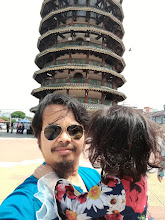TERMINATION OF PREGNANCY
Introduction
Dealing with termination of
pregnancy can be emotionally difficult for both patients and doctors involved.
With wide variety of opinions out there, often there would be some doubt as to
whether this termination is Islamically allowed or not, or whether am I too
lenient or strict with the termination of pregnancy.
Most recent discussion by Dr
Yasir Qadhi (Contemporary religious scholar) & Dr Hatem (Paediatrician with
PhD in Comparative Fiqh) in Youtube triggers the need for me to put things in
writing for my reference in future. And I hope it will help the readers to find
their own directions as well.
Stages of foetal development
Old jurists made distinction of permissibility
based on timing of termination – using 40 days and 120 days as the gateway. Why
40 and 120 days, one must ask? This is mainly based on ahadith that mentioned
40 days as the time when the product of conception is still in early stage and
120 days (of conception) as the time when Ruh was breathed into the foetus.
Medically, embryogenesis is
nearly complete by 40 days of conception. That means, the product of conception
already has many features of fully formed human. There is already sign of heart
beating by 6 weeks of gestation. However, islamically, this does not equate to
ensoulment (Ruh breathed into being). Many scholars still take 120 days as the
time of ensoulment. With the embryo passed the stage of ensoulment, it has now
become fully sanctified human life, Islamically speaking.
In the Quran, Allah said: Then
We made the sperm-drop into a clinging clot, and We made the clot into a lump
[of flesh], and We made [from] the lump, bones, and We covered the bones with
flesh; then We developed him into another creation. So blessed is Allah, the
best of creators. (Surah Al-Mukminun, verse 14). Ali r.a commented during
discussion of the permissibility of ‘azl (coitus interruptus) that the product
of conception went through 7 stages of development before it is given a soul. Hence,
‘azl cannot be considered as infanticide.
For what reason abortion is
permissible in Islam?
There were wide range of opinion
regarding abortion in Islam. The classical Maliki school is the strictest –
they opposed any intervention as means of birth control. While dominant Hanafi
position is the most lenient for abortion within 120 days. Most classical
jurists would allow abortion when the product of conception is less than 40-day
old (around 8 weeks of pregnancy), even when the reasons are considered ‘soft’
by today’s standard. One thing that was stressed is that abortion cannot be
done for afraid of being poor, as this is directly against the Quran’s teaching:
And do not kill your children for
fear of poverty. We provide for them and for you. Indeed, their killing is ever
a great sin. (Surah Al-Israa’: verse 31.)
Abortion after 40 days (and
before Ruh is breathed into it, at 120 days) required more concrete reasons
(darurah), such as disturbance to the health of mothers and severe congenital
malformation. A pregnancy because of rape can also be considered for
termination, if it has not passed the 120 days or around 19 weeks of pregnancy.
To what extent, the health of the
mother is jeopardised before termination of pregnancy can be considered? This
is to certain extent, quite subjective. Being pregnant itself, without having
any other additional risk, carries higher morbidity and mortality risk,
compared to non-pregnant woman – but that is not enough to warrant abortion on
demand. Interestingly, some previous jurists would even allow termination
of early pregnancy for fear of a current-breastfed child may not be able to
suckle and suffer from malnourishment and death. So, according to many classical
scholars, termination of pregnancy can be considered within 120 days for any
significant health risk to the mother.
Abortion after 120 days
From jurists’ viewpoints, because
of the landmark 120 days (about 19 weeks) for the soul to be breathed into,
they considered abortion after that is illegal and punishable by law. The only
reason it can be allowed if it deals with the life and death situation of the
mother, or for delivery of dead foetus.
Termination of pregnancy under
current setting
Regardless of the stage of
pregnancy or whether the Ruh has been breathed in or not, abortion in an
established pregnancy for social reason is less likely to be performed
nowadays. Reasons for which termination may be considered in the olden days, such
as Down Syndrome baby or worried of breastfeeding-child, is no more considered
major reason for termination. Even when there is increased risk to the mother
during pregnancy, for example, by having kidney problem or hypertension; termination
of pregnancy may be discussed and not necessarily offered as the first choice.
Conclusion
There was more leniency with the verdict of termination of pregnancy in classical jurists than what we are accustomed to nowadays. With the advancement of medical treatment, some risks during pregnancy are more manageable compared to the olden days, lowering the overall risk of complication to the pregnant mother. With the available helps as well, many babies that were born with disabilities may continue to live meaningful life.
This is by no mean enough for one to decide whether termination should be done or not, but perhaps it should serve as basic knowledge to carry out further research and discussion.
Reference:
1. Youtube video of Dr Yasir Qadhi and Dr Hatem el-Haj. 2020. https://www.youtube.com/watch?v=bd6pLHPtBSg
2. The Fiqh of Medicine (2001) by Ahmed Abdel Aziz Yacoub (Ta-Ha Publishers Ltd)
3. Islam and Abortion Debate, by Dr Omar Suleiman (Yaqeen Institute). 2017. https://yaqeeninstitute.org/omar-suleiman/islam-and-the-abortion-debate/
